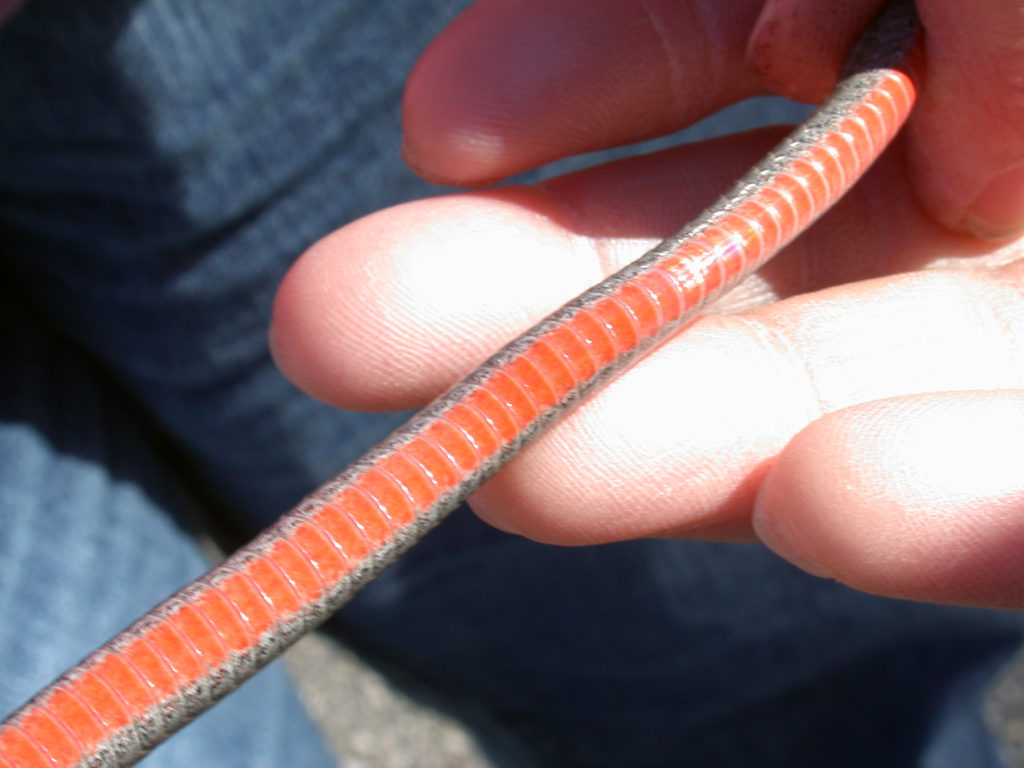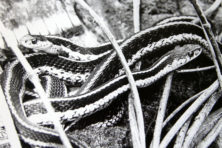Door to Nature: Harmless Snakes Need Protection
- Share
- Tweet
- Pin
- Share

Just the mention of snakes can make some people writhe in fear or disgust. A bad experience may have made them feel this way, but the snakes that are native to Door County are all nonpoisonous and need to be protected and appreciated.
I found a dead red-bellied snake on the brick path in my front yard recently and felt sorry for its demise because it is one of the most gentle and harmless creatures and has beautiful markings.

I held a red-bellied snake, with its ventral side showing the red-orange color, for Roy to photograph. Photo by Roy Lukes.
My late husband, Roy, was teaching an autumn class at The Clearing perhaps 40 years ago, and it was a chilly day as we hiked a wooded area near Lake Michigan. On the trail ahead of us, a student discovered a red-bellied snake that was very still. It was so cold, and it seemed somewhat lethargic. I picked it up and wrapped it between my fingers. Apparently it enjoyed the warmth of my hand and soon perked up.
Snakes are not to be feared. They do a great service in eating many small rodents, earthworms, snails, slugs and especially soft-bodied insects and their larvae. Members of the reptile family, they have skin that’s scaly and dry. The fact that they can move so swiftly without legs is a marvel.
Nearly all snakes have broad plates on their undersides that overlap slightly. Every plate is capable of some movement courtesy of a complex arrangement of muscles that allow the snake to travel forward in a caterpillar-like fashion. Each of the backward-pointing scales catch and hold some of the irregularities on the surfaces over which they travel.
A snake’s tongue is its sensory organ: It “tastes” the air and picks up minute particles that the tips carry inside the mouth to two tiny cavities that are lined with sensory cells. Snakes’ senses of sight and smell are also well developed, which is a good thing: Their ability to detect food and mates depends greatly on these two faculties.
On the other hand, snakes are apparently deaf to airborne sounds because there have no external ear openings. They also lack eyelids, so their eyes remain open all the time, even when they sleep. The transparent disk that covers each eye is shed along with the rest of the skin as they grow.
Young snakes grow rapidly, and some kinds mature in about three years. Many eat nothing before their first winter of hibernation, so when they emerge in the spring, they have a great appetite.
The northern red-bellied snake is a forest inhabitant that can also live in gardens and near wetlands. It thrives on slugs, so it prefers to be in moist areas. It is found in many parts of eastern North America except the Florida peninsula and is one of the smallest snakes – only eight to 16 inches long.
Another small, docile, slender snake in our region is the northern brown snake, which is also known as the DeKay’s snake. It averages nine to 13 inches in length but can reach up to 21 inches.
One fall, we were hiking with friends and found a northern brown snake – again, quite motionless on the cold ground. I picked it up so that Roy could photograph it, but it soon warmed up in my hands and squirmed around a bit. I squeezed the body to hang on to it but pressed the wrong part: The snake emitted a foul excretion that made my hands smell so bad that even washing them could not get rid of the odor.
That is one of snakes’ methods of defense. They can flatten their body and emit a rather foul-smelling musk from their scent glands at the base of the tail. We all smelled the slimy substance and agreed that it was not as putrid as that given out by the eastern garter snake.
The primary color of the northern brown snake is a subtle grayish-tan. Two parallel rows of blackish spots neatly decorate almost the entire length of the upper body, and there is a small, dark blotch behind the head on both sides of the neck.
One of the most likely places to see brown snakes in fall is on paved roads as they cross to reach their winter quarters. If you discover one of these winter habitations, you will most likely find several red-bellied snakes there, too, because they often find abandoned burrows or ant hills in which to spend the cold-weather months.
As small and delightful as the northern red-bellied and brown snakes are to handle, it’s best to let them stay in the wild. Admire them where you find them – partners in nature – but let them find their safe spots to live.

